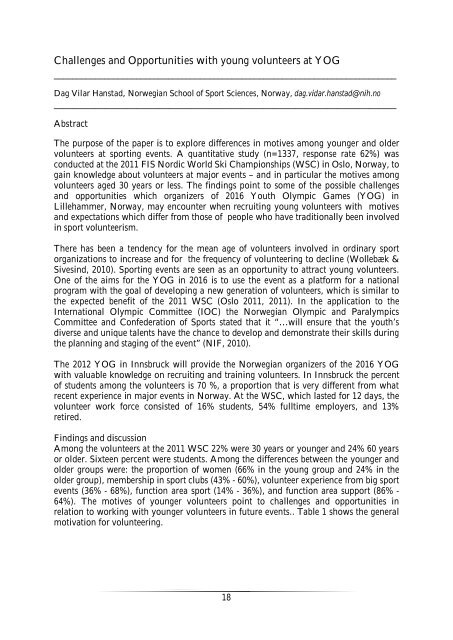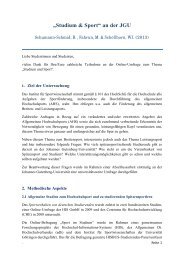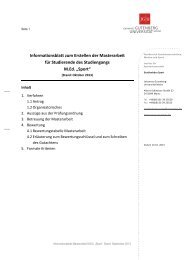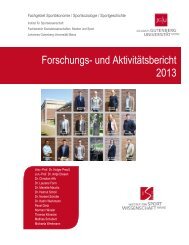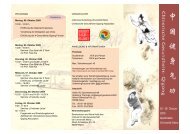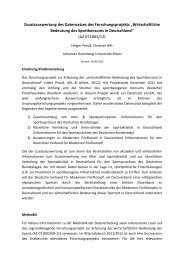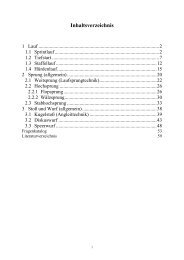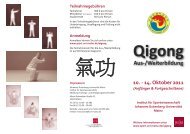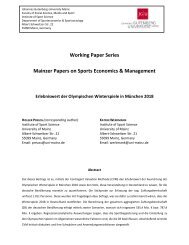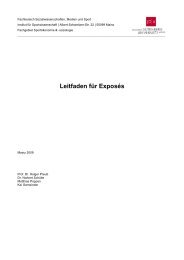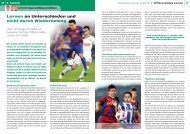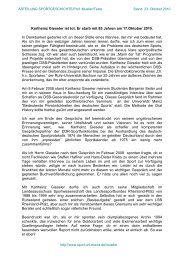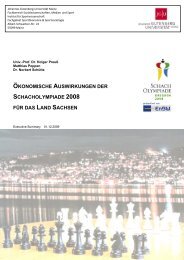Book of Abstracts - Fachbereich Sport der Universität Mainz ...
Book of Abstracts - Fachbereich Sport der Universität Mainz ...
Book of Abstracts - Fachbereich Sport der Universität Mainz ...
Create successful ePaper yourself
Turn your PDF publications into a flip-book with our unique Google optimized e-Paper software.
Challenges and Opportunities with young volunteers at YOG<br />
___________________________________________________________________________<br />
Dag Vilar Hanstad, Norwegian School <strong>of</strong> <strong>Sport</strong> Sciences, Norway, dag.vidar.hanstad@nih.no<br />
___________________________________________________________________________<br />
Abstract<br />
The purpose <strong>of</strong> the paper is to explore differences in motives among younger and ol<strong>der</strong><br />
volunteers at sporting events. A quantitative study (n=1337, response rate 62%) was<br />
conducted at the 2011 FIS Nordic World Ski Championships (WSC) in Oslo, Norway, to<br />
gain knowledge about volunteers at major events – and in particular the motives among<br />
volunteers aged 30 years or less. The findings point to some <strong>of</strong> the possible challenges<br />
and opportunities which organizers <strong>of</strong> 2016 Youth Olympic Games (YOG) in<br />
Lillehammer, Norway, may encounter when recruiting young volunteers with motives<br />
and expectations which differ from those <strong>of</strong> people who have traditionally been involved<br />
in sport volunteerism.<br />
There has been a tendency for the mean age <strong>of</strong> volunteers involved in ordinary sport<br />
organizations to increase and for the frequency <strong>of</strong> volunteering to decline (Wollebæk &<br />
Sivesind, 2010). <strong>Sport</strong>ing events are seen as an opportunity to attract young volunteers.<br />
One <strong>of</strong> the aims for the YOG in 2016 is to use the event as a platform for a national<br />
program with the goal <strong>of</strong> developing a new generation <strong>of</strong> volunteers, which is similar to<br />
the expected benefit <strong>of</strong> the 2011 WSC (Oslo 2011, 2011). In the application to the<br />
International Olympic Committee (IOC) the Norwegian Olympic and Paralympics<br />
Committee and Confe<strong>der</strong>ation <strong>of</strong> <strong>Sport</strong>s stated that it “…will ensure that the youth’s<br />
diverse and unique talents have the chance to develop and demonstrate their skills during<br />
the planning and staging <strong>of</strong> the event” (NIF, 2010).<br />
The 2012 YOG in Innsbruck will provide the Norwegian organizers <strong>of</strong> the 2016 YOG<br />
with valuable knowledge on recruiting and training volunteers. In Innsbruck the percent<br />
<strong>of</strong> students among the volunteers is 70 %, a proportion that is very different from what<br />
recent experience in major events in Norway. At the WSC, which lasted for 12 days, the<br />
volunteer work force consisted <strong>of</strong> 16% students, 54% fulltime employers, and 13%<br />
retired.<br />
Findings and discussion<br />
Among the volunteers at the 2011 WSC 22% were 30 years or younger and 24% 60 years<br />
or ol<strong>der</strong>. Sixteen percent were students. Among the differences between the younger and<br />
ol<strong>der</strong> groups were: the proportion <strong>of</strong> women (66% in the young group and 24% in the<br />
ol<strong>der</strong> group), membership in sport clubs (43% - 60%), volunteer experience from big sport<br />
events (36% - 68%), function area sport (14% - 36%), and function area support (86% -<br />
64%). The motives <strong>of</strong> younger volunteers point to challenges and opportunities in<br />
relation to working with younger volunteers in future events.. Table 1 shows the general<br />
motivation for volunteering.<br />
18


